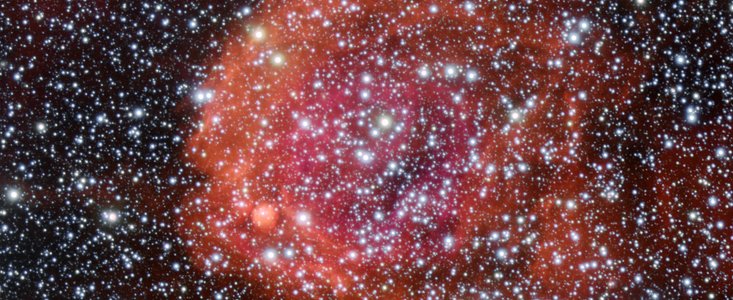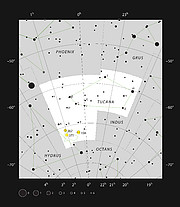Persbericht
De rozerode gloed van stervorming
30 maart 2011
De helderrode wolk op deze nieuwe opname van ESO’s Very Large Telescope is een gebied van gloeiend waterstofgas rond de sterrenhoop NGC 371. Deze kraamkamer van sterren maakt deel uit van ons buurstelsel, de Kleine Magelhaense Wolk.
Het object dat deze foto domineert mag dan op een plasje bloed lijken, maar zo macaber is het niet. Zo’n gebied van geïoniseerd waterstofgas – ook wel HII-gebied genoemd – is juist een plek waar recent veel nieuwe sterren zijn geboren. NGC 371 is daar een voorbeeld van: het is een open sterrenhoop, gehuld in een gasnevel. De sterren in een open sterrenhoop zijn allemaal uit hetzelfde diffuse HII-gebied ontstaan. Mettertijd raakt het waterstofgas grotendeels op aan de vorming van hete, nieuwe sterren, waardoor er slechts een schil van waterstof resteert, zoals die op deze foto.
NGC 371 maakt deel uit van de Kleine Magelhaense Wolk, een dwergstelsel op een afstand van slechts 200.000 lichtjaar dat daarmee een van de meest nabije buren van onze Melkweg is. De Kleine Magelhaense Wolk bevat sterren in allerlei evolutiestadia – van de zeer heldere, jonge sterren van NGC 371 tot de restanten van sterren die als supernova zijn ontploft. Deze energieke jonkies zenden enorme hoeveelheden ultraviolette straling uit waardoor omringend gas, zoals het overgebleven waterstof van hun moedernevel, tot op afstanden van honderden lichtjaren aan het gloeien wordt gebracht. Dat verschijnsel is op deze foto – gemaakt met het FORS1-instrument van ESO’s Very Large Telescope (VLT) – mooi te zien.
Open sterrenhopen zijn allesbehalve zeldzaam – ook in ons eigen melkwegstelsel zijn er veel te vinden. Maar NGC 371 onderscheidt zich door het buitengewoon grote aantal veranderlijke sterren dat hij bevat. Dat zijn sterren die in de loop van de tijd van helderheid veranderen. Een bijzonder interessant soort veranderlijke sterren, die traag pulserende B-sterren worden genoemd, kan worden gebruikt voor het onderzoek van het inwendige van sterren door middel van asteroseismologie [1]. In deze sterrenhoop zijn verscheidene van deze sterren aangetroffen. Veranderlijke sterren spelen een cruciale rol in de astronomie: sommige soorten zijn onmisbaar voor de bepaling van de afstanden van verre sterrenstelsels en de leeftijd van het heelal.
De gegevens voor deze foto werden, in het kader van de wedstrijd Hidden Treasures [2], door Manu Mejias uit het ESO-archief opgedoken. Drie van Manu’s foto’s haalden de top 20; zijn foto van NGC 371 eindigde op de zesde plaats.
Noten
[1] Asteroseismologie is het onderzoek van de inwendige bouw van pulserende sterren aan de hand van de verschillende frequenties waarin deze sterren trillen. Dat is vergelijkbaar met het onderzoek van de bouw van de aarde met behulp van de trillingen die aardbevingen in het inwendige van onze planeet veroorzaken.
[2] ESO’s fotowedstrijd Hidden Treasures 2010 stelde amateurastronomen in de gelegenheid om de enorme ESO-archieven door te spitten op onvermoede astronomische juweeltjes die opgepoetst moesten worden. De deelnemers stuurden bijna honderd inzendingen in, en tien van hen werden beloond met aantrekkelijke prijzen, waaronder een volledig verzorgde reis naar ESO’s Very Large Telescope op Cerro Paranal in Chili voor de winnaar. De tien prijswinnaars stuurden alles bij elkaar twintig foto’s in.
Meer informatie
ESO, de Europese Zuidelijke Sterrenwacht, is de belangrijkste intergouvernementele sterrenkundeorganisatie in Europa, en het meest productieve astronomische observatorium ter wereld. ESO wordt ondersteund door 15 landen: België, Brazilië, Denemarken, Duitsland, Finland, Frankrijk, Italië, Nederland, Oostenrijk, Portugal, Spanje, Tsjechië, het Verenigd Koninkrijk, Zweden en Zwitserland. ESO voert een ambitieus programma uit, gericht op het ontwerp, de bouw en het beheer van krachtige grondobservatoria die astronomen in staat stellen om belangrijke wetenschappelijke ontdekkingen te doen. ESO speelt ook een leidende rol bij het bevorderen en organiseren van samenwerking op sterrenkundig gebied. ESO beheert drie waarnemingslocaties van wereldklasse in Chili: La Silla, Paranal en Chajnantor. Op Paranal staat ESO’s Very Large Telescope (VLT), de meest geavanceerde optische sterrenwacht ter wereld. Ook is ESO de Europese partner van de revolutionaire telescoop ALMA, het grootste sterrenkundige project van dit moment. Daarnaast bereidt ESO momenteel de bouw voor van de 42-meter Europese Extremely Large optische/nabij-infrarood Telescoop (E-ELT), die ‘het grootste oog op de hemel’ ter wereld zal worden.
Contact
Richard Hook
ESO, La Silla, Paranal, E-ELT and Survey Telescopes Press Officer
Garching bei München, Germany
Tel: +49 89 3200 6655
E-mail: rhook@eso.org
Marieke Baan (Perscontact Nederland)
ESO Science Outreach Network
en NOVA Informatie Centrum
Tel: +31(0)20-5257480
E-mail: eson-netherlands@eso.org
Over dit bericht
| Persberichten nr.: | eso1111nl |
| Naam: | NGC 371 |
| Type: | Local Universe : Star : Grouping : Cluster : Open |
| Facility: | Very Large Telescope |
| Instruments: | FORS1 |
Our use of Cookies
We use cookies that are essential for accessing our websites and using our services. We also use cookies to analyse, measure and improve our websites’ performance, to enable content sharing via social media and to display media content hosted on third-party platforms.
ESO Cookies Policy
The European Organisation for Astronomical Research in the Southern Hemisphere (ESO) is the pre-eminent intergovernmental science and technology organisation in astronomy. It carries out an ambitious programme focused on the design, construction and operation of powerful ground-based observing facilities for astronomy.
This Cookies Policy is intended to provide clarity by outlining the cookies used on the ESO public websites, their functions, the options you have for controlling them, and the ways you can contact us for additional details.
What are cookies?
Cookies are small pieces of data stored on your device by websites you visit. They serve various purposes, such as remembering login credentials and preferences and enhance your browsing experience.
Categories of cookies we use
Essential cookies (always active): These cookies are strictly necessary for the proper functioning of our website. Without these cookies, the website cannot operate correctly, and certain services, such as logging in or accessing secure areas, may not be available; because they are essential for the website’s operation, they cannot be disabled.
Functional Cookies: These cookies enhance your browsing experience by enabling additional features and personalization, such as remembering your preferences and settings. While not strictly necessary for the website to function, they improve usability and convenience; these cookies are only placed if you provide your consent.
Analytics cookies: These cookies collect information about how visitors interact with our website, such as which pages are visited most often and how users navigate the site. This data helps us improve website performance, optimize content, and enhance the user experience; these cookies are only placed if you provide your consent. We use the following analytics cookies.
Matomo Cookies:
This website uses Matomo (formerly Piwik), an open source software which enables the statistical analysis of website visits. Matomo uses cookies (text files) which are saved on your computer and which allow us to analyze how you use our website. The website user information generated by the cookies will only be saved on the servers of our IT Department. We use this information to analyze www.eso.org visits and to prepare reports on website activities. These data will not be disclosed to third parties.
On behalf of ESO, Matomo will use this information for the purpose of evaluating your use of the website, compiling reports on website activity and providing other services relating to website activity and internet usage.
Matomo cookies settings:
Additional Third-party cookies on ESO websites: some of our pages display content from external providers, e.g. YouTube.
Such third-party services are outside of ESO control and may, at any time, change their terms of service, use of cookies, etc.
YouTube: Some videos on the ESO website are embedded from ESO’s official YouTube channel. We have enabled YouTube’s privacy-enhanced mode, meaning that no cookies are set unless the user actively clicks on the video to play it. Additionally, in this mode, YouTube does not store any personally identifiable cookie data for embedded video playbacks. For more details, please refer to YouTube’s embedding videos information page.
Cookies can also be classified based on the following elements.
Regarding the domain, there are:
- First-party cookies, set by the website you are currently visiting. They are stored by the same domain that you are browsing and are used to enhance your experience on that site;
- Third-party cookies, set by a domain other than the one you are currently visiting.
As for their duration, cookies can be:
- Browser-session cookies, which are deleted when the user closes the browser;
- Stored cookies, which stay on the user's device for a predetermined period of time.
How to manage cookies
Cookie settings: You can modify your cookie choices for the ESO webpages at any time by clicking on the link Cookie settings at the bottom of any page.
In your browser: If you wish to delete cookies or instruct your browser to delete or block cookies by default, please visit the help pages of your browser:
Please be aware that if you delete or decline cookies, certain functionalities of our website may be not be available and your browsing experience may be affected.
You can set most browsers to prevent any cookies being placed on your device, but you may then have to manually adjust some preferences every time you visit a site/page. And some services and functionalities may not work properly at all (e.g. profile logging-in, shop check out).
Updates to the ESO Cookies Policy
The ESO Cookies Policy may be subject to future updates, which will be made available on this page.
Additional information
For any queries related to cookies, please contact: pdprATesoDOTorg.
As ESO public webpages are managed by our Department of Communication, your questions will be dealt with the support of the said Department.



